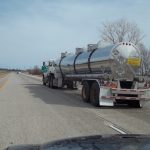If you offer for transportation a hazardous material (HazMat) on a shipping paper such as a bill of lading or a hazardous waste on the Uniform Hazardous Waste Manifest (required for both large and small quantity generators of hazardous waste) you must provide an emergency response telephone number for use in the event of an emergency. I have found many shippers to be unaware of their responsibility regarding this matter as they rely on the carrier and/or designated facility to provide the information required by 49 CFR 172.604.
This article was updated November 01, 2019 to reflect changes made to the regulations since its first publication on March 27, 2012.
The purpose of the emergency response telephone number is that it be a source of helpful information for emergency responders in the event of a HazMat Incident, therefore the number must be:
- Monitored at all times the hazardous material is in transportation until it reaches its designated facility and is removed from transportation.
And…
- The number of a person who is knowledgeable of the HazMat being shipped and has comprehensive emergency response information and incident mitigation information for that material.
Or…
- Has immediate access to a person who has such knowledge and information. Telephone numbers that require a call back such as an answering service, beeper, or answering machine will not suffice (LOI 01-0176).
This knowledgeable person monitoring the telephone 24/7 (if necessary) is known as the Emergency Response Information Provider or the ERI Provider.
It is important that the emergency response telephone number is clearly visible in the event of an emergency, therefore the number must be written on the shipping paper:
- Immediately following the description of the hazardous material (this would be Section 9b of the Uniform Hazardous Waste Manifest).
- Entered once on the shipping paper in a “prominent, readily identifiable, and clearly visible manner…” This can be done by using a larger or differently colored font, highlighting, or otherwise setting the number apart. It must also be indicated on the shipping paper that the number is for emergency response information (e.g., “EMERGENCY CONTACT ###”). This option can only be used if the number applies to each hazardous material on the shipping paper. Section 3 of the Uniform Hazardous Waste Manifest may be used to fulfill this requirement.
Unfortunately some shippers and carriers were using the phone numbers of ERI Providers that they had not registered with to provide such service and in an emergency first responders were not able to obtain the necessary information from the ERI Provider. For this reason, effective October 1, 2010, some form of identification of the person who has registered with the ERI Provider must be included on the shipping paper. Note that the name of the ERI Provider is not required to appear on the shipping paper, merely their phone number (LOI 11-0152, LOI 10-0262). However the name of the person that has contracted or registered with the ERI Provider to perform this service must be identified on the shipping paper. Identification can be by name, contract number, or other unique identifier of the ERI Provider for the registrant and it must be near the emergency response telephone number unless it appears elsewhere on the shipping paper in a prominent, readily identifiable, and clearly visible manner.
So, if the person offering the hazardous material for shipment is also the ERI Provider, their name or some other acceptable means of identification must appear prominently and clearly on the shipping paper. For the Uniform Hazardous Waste Manifest this is accomplished by proper completion of Section 5. If a 3rd party is contracted to be the ERI Provider then some identification linking them to the registrant (name, contract number or other unique identified of the ERI Provider) must be clearly visible on the shipping paper (LOI 10-0146). This information could be recorded in Section 14 of the Uniform Hazardous Waste Manifest.
If using a 3rd party, it is the responsibility of the person registered with the ERI Provider to ensure they have the current information on the material before it is offered for shipment. This is especially important for hazardous waste shipments as the wastes may be different for each pickup.
49 CFR 172.604(b) can be difficult to read and understand (It was much more challenging for me than I thought it would be) but the intent is clear: some information linking the ERI Provider to the person offering the hazardous material for shipment must be clearly visible on the shipping paper for emergency responders to find. As of June 2011, the Agency was aware of the confusing text of this regulation and will be taking steps to clarify it (11-0008).
For telephone numbers outside the US, the international access code or the “+” sign, country code, and city code as appropriate must be included.
If preparing shipping papers for the continued transportation of a hazardous material, it is the responsibility of the subsequent offeror to ensure if the original or previous emergency response telephone number is authorized for that shipment. In such a situation, the subsequent offeror may choose to use their own ERI Provider (11-0005).
The requirement to include an emergency response telephone number do not apply to:
- Limited Quantities offered for transportation pursuant to 49 CFR 173.150-156 & 173.306.
- Transportation vehicles or freight containers with lading that has been fumigated and displays the FUMIGANT marking, as long as no other hazardous materials are present.
- Materials properly described under the following shipping names:
- Battery powered equipment.
- Battery powered vehicle.
- Carbon dioxide, solid.
- Castor bean, castor flake, castor meal, or castor pomace.
- Consumer commodity.
- Dry ice.
- Engines, internal combustion.
- Fish meal, stabilized or fish scrap, stabilized.
- Refrigerating machine.
- Vehicle, flammable gas powered.
- Vehicle, flammable liquid powered.
- Wheelchair, electric.
Prior to your next shipment, ensure that you are in compliance with these important regulations. Significant penalties will be assessed if the emergency response telephone number for a shipment of your hazardous waste or hazardous material is discovered to be incorrect or incomplete during a hazardous material incident or emergency. You must also ensure proper training of your HazMat Employees and the employees of a Large Quantity Generator of hazardous waste who handle the waste, including preparing it for shipment or signing the Uniform Hazardous Waste Manifest. Please contact me to schedule on-site training.


